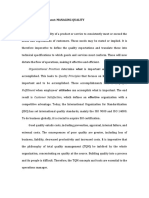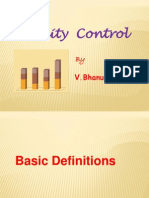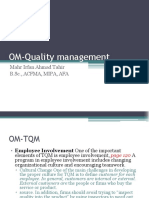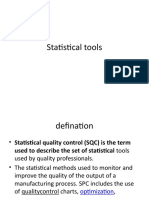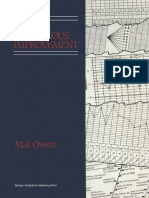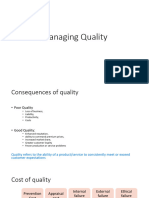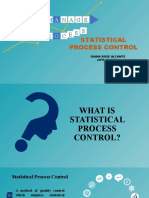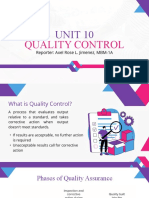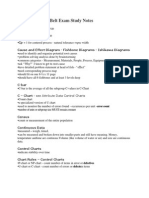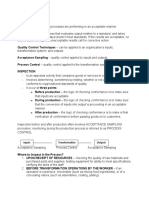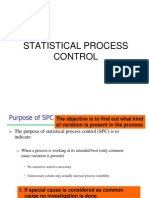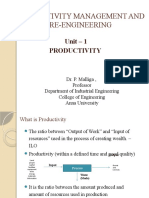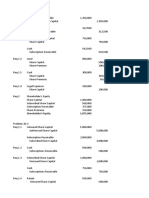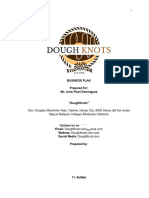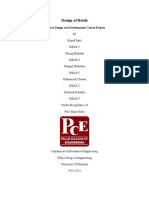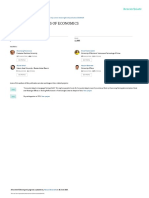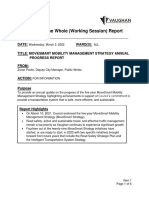Process Control & Improvement Tools
Control Charts
● Definition:
○ Statistical tools in Statistical Process Control (SPC) used to monitor if a
process is in control over time.
○ Also called Shewhart Control Charts, named after W. A. Shewhart, who
pioneered these methods.
● Function:
○ Unlike acceptance sampling (detects defects after production), control charts
prevent production of defectives by identifying process deviations early.
● Key Features:
○ Time-sequenced charts showing:
■ Plotted values of a statistic
■ Centerline average
■ Upper Control Limit (UCL) and Lower Control Limit (LCL)
○ Any point outside control limits signals a potential problem requiring
investigation.
● Theoretical Basis is the Central Limit Theorem:
○ Averages of many random samples will form a normal distribution, allowing
prediction of process performance.
○ Helps determine if a process is ‘in control’ or ‘out of control’.
Types of Control Charts
○ For Variables (measurable physical quantities like weight, length)
■ X̄-Chart (Mean Chart):
● Monitors process average (mean quality level).
● The X̄-Chart is constructed from subgroup averages.
■ R-Chart (Range Chart):
● Monitors process variability (dispersion).
● R-Chart uses the range within subgroups to assess variability.
○ For Attributes (counting data)
■ p-Chart:
● Measures proportion of defectives in a sample.
■ c-Chart:
● Measures count of defects per unit,
● Used when defects are rare but opportunities are high.
Short Run Control Charts
● Used for short production runs where collecting large sample sizes is impractical.
● Plots data from multiple parts on the same chart for efficient monitoring.
�Acceptance sampling
● Definition
○ Quality control method used to decide whether to accept or reject a
batch (lot) of products.
○ Involves inspecting a sample for efficiency.
● Key Statistical Principles
○ Lot size: Total units in the batch.
○ Sample size: Number of units inspected.
○ Acceptance number: Max allowable defects for accepting the lot.
● Risks
○ Type I Error (α-risk): Rejecting a good lot.
○ Type II Error (β-risk): Accepting a bad lot.
● Application by Production Type
○ Jobbing Production (low volume, customized): 100% inspection.
○ High Volume Production: 100% inspection impractical;
■ Uses acceptance sampling to measure variation via samples.
● Types of Sampling
○ Sampling by Attributes
■ Yes/No decisions (within specs or not).
■ Uses gauges; less effort and resources.
■ Limitation: Indicates quality changes but not by how much.
■ Applicable to products and services.
○ Sampling by Variables
■ Measures actual values (e.g. weight, length, time).
■ Requires equipment, skills, and time.
■ Smaller sample sizes needed for the same protection level, which
can offset higher unit inspection cost.
■ Used when actual measurements or destructive testing are needed.
● Sampling Plans
○ Single Sampling Plan
■ One sample of size n is taken.
■ If defects ≤ acceptance number c, lot is accepted;
■ Otherwise rejected.
○ Double Sampling Plan
■ Two-stage sampling with two acceptance numbers.
■ First sample may lead to accept/reject or
■ Require a second sample for final decision.
○ Multiple Sampling Plan
■ Also called sequential sampling.
■ Multiple small samples taken sequentially until cumulative evidence
justifies accept/reject decision.
■ Often uses fewer units overall than double sampling.
�Productivity
● Definition
○ Productivity = Output / Input
○ Measures efficiency in converting inputs (labor, materials, capital, time) into
outputs.
○ Higher productivity indicates better resource utilization and cost-effectiveness.
● Types of Productivity Measures
○ Labor Productivity: Output per labor hour.
○ Capital Productivity: Output per unit of capital invested.
○ Material Productivity: Output per unit of material used.
○ Multifactor Productivity: Output compared to multiple combined inputs.
○ Total Factor Productivity (TFP): Output per all inputs considered.
● Effectiveness vs Efficiency
○ Effectiveness: More output with the same input.
○ Efficiency: Same output with less input.
○ Productivity is both effectiveness and efficiency combined.
● Productivity vs. Production
○ Productivity: Ratio (Output/Input).
○ Production: Volume of output.
○ Increased production ≠ increased productivity if inputs rise proportionally.
● Importance of Productivity
○ Indicator of organizational health and competitiveness.
○ Impacts profits and national standard of living.
○ No organization is exempt from potential productivity improvement.
● Enhance Productivity:
○ Methods
■ Technology, Innovation, Automation
■ Learning and Experience curve
■ Job Design, Work Analysis, Motivation
○ Objective
■ Efficiency
■ Maximum output
■ Elimination of waste
■ Better standard of living
● Productivity in Manufacturing vs Service
○ Productivity gains are higher in manufacturing than in services.
● Productivity paradox:
○ Technology investments in services do not immediately reflect in productivity
statistics.
● Productivity Tree Concept
○ Roots (Inputs): Labor, capital, materials, energy.
○ Trunk (Process): Conversion process.
○ Fruits (Outputs): Goods/services produced.
�Non-Productivity Measures
● Definition
○ Metrics that do not directly contribute to output, but significantly impact:
■ Operational performance
■ Efficiency
■ Quality
■ Organizational health
● Importance
○ Though not directly tied to production, they identify areas for improvement,
manage costs, and ensure a healthy work environment.
● Overall Role
○ NPM is tracked via surveys, audits, assessments.
○ Critical for continuous improvement, operational resilience, and long-term
competitiveness.
● Key Categories and Examples
○ Quality Metrics
■ Indicates process quality and efficiency.
■ High defects or rework increase costs and reduce customer satisfaction.
○ Employee Engagement & Satisfaction
■ High turnover or absenteeism indicates low morale.
■ Training improves skills but requires time and resources.
○ Maintenance & Downtime
■ Downtime reduces production availability.
■ High maintenance costs may indicate process inefficiencies.
○ Process Delays & Waiting Time
■ Long times indicate inefficiencies, bottlenecks, or poor process flow.
○ Overhead Costs
■ Necessary costs that do not directly produce output.
■ Excess overhead cost signals inefficiency.
○ Compliance & Risk Management
■ Legal, safety, and quality compliance issues reduce operational stability
and profitability.
○ Customer Satisfaction & Service Metrics
■ Indicates product/service issues and organizational responsiveness.
○ Innovation & Process Improvement
■ Indicate focus on continuous improvement and future productivity growth.







